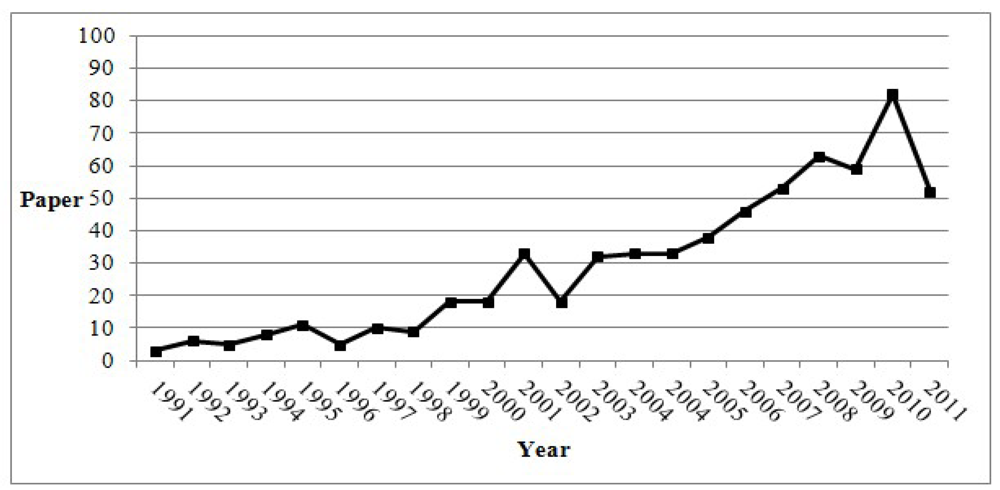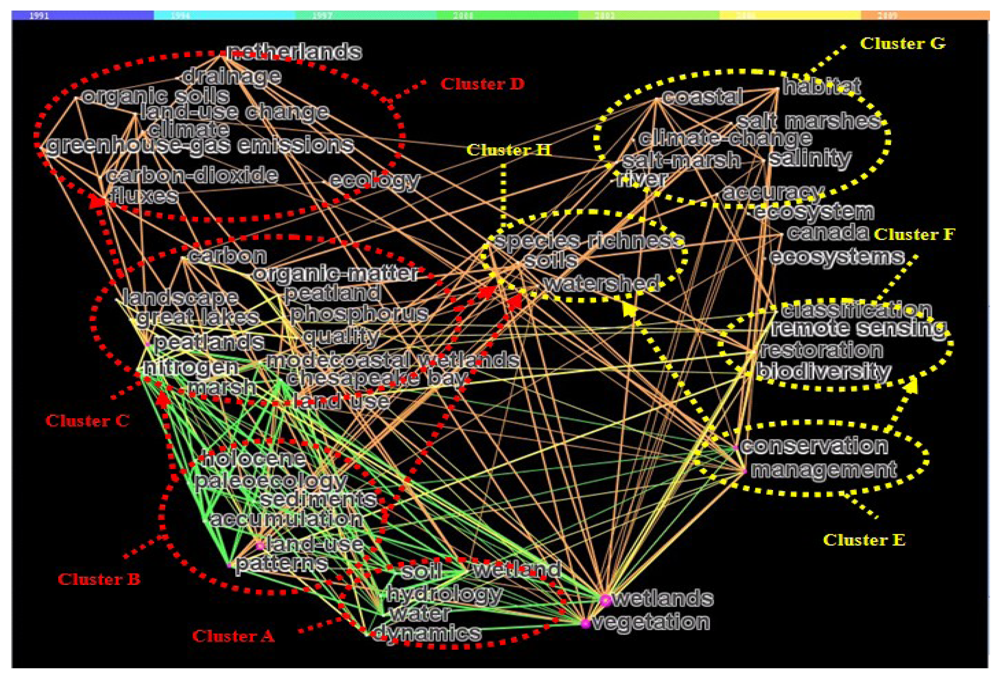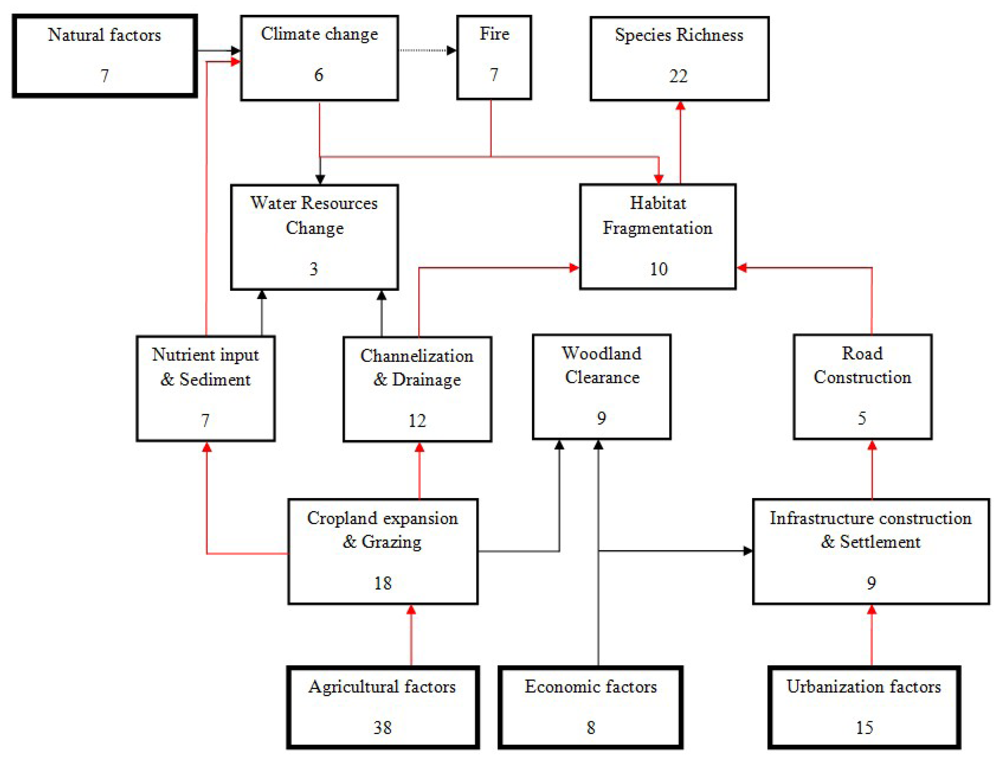1. Introduction
Wetlands, areas that are saturated with moisture and, as a consequence, contain unique land cover classes, are some of the most diverse ecosystems in the world. Wetlands provide a wide range of ecosystem services such as groundwater recharge, attenuated nutrient runoff, habitat generation, and contaminant stabilization [
1]. A comprehensive definition for wetlands, developed during a 1971 convention in Ramsar, Iran, states that wetlands include: marshes, fens, and peatlands that are natural, artificial, permanent, or temporary with fresh, brackish, or salt water that is static or flowing. Many factors exert an influence on wetland stability or degradation; based on a scenario simulation of Millennium Ecosystem Assessment [
2], habitat change is currently the driving force behind modifications in wetland function. Moreover, land use and land cover change influence the total amount of wetland in most regions [
3,
4,
5].
In this article we investigated comparisons between different wetland types, beneficial characteristics of wetlands, and causes of wetland loss. While all three topics have motivated extensive research, we tested whether research on wetlands is topic-centered, comparative of different wetland classes, or aimed at wetland loss. We analyzed research papers to identify clusters of research activity and interpreted these clusters relative to wetland function and type.
2. Materials and Methods
Citespace, a bibliometric visualization tool, was used to investigate research topic changes and draw a knowledge map [
6,
7]. This tool traces changes in keywords along a timeline, which vary based on the tool’s automatic classification and cluster function. Determination of keywords is vital for gaining objective and unbiased data sources for literature analysis. Literature keywords (
i.e., wetland type, ecology, land use, and land cover) and number of paper citations were analyzed to demonstrate variation in hot research topics over the last two decades. Wetland classes including marsh, fen, and peatland were selected as keywords as were wetlands providing a wide range of ecosystem services. Lastly, land use and land cover were used together to define wetland loss.
After determining queries using a series of keywords in Citespace, 604 papers, representing research from 1991 to 2011, were downloaded and used as data. The download language was English and literature type was “article”. Knowledge maps that determined study characteristics and tracked changes over a 21-year research period were produced (See
Table 1). Web of Science (WOS) was used to locate 61 high impact wetland papers; these were regarded as referred papers with the most pioneering views in each field. The bibliometric visualization tool was used to focus on these 61 papers.
Table 1.
Literature query formation in Web of Science.
Table 1.
Literature query formation in Web of Science.
| | Query formation | Language | Document Type | Timespan | Results |
|---|
| #1 | TS=”land use” | English | Article | All years | 37171 |
| #2 | TS=”land cover” | English | Article | All years | 8854 |
| #3 | #1 or #2 | English | Article | All years | 38470 |
| #4 | TS=peatland | English | Article | All years | 2230 |
| #5 | TS=marsh | English | Article | All years | 15998 |
| #5 | TS=fen | English | Article | All years | 3357 |
| #7 | #4 or #5 or #6 | English | Article | All years | 20844 |
| #8 | #3 and #7 | English | Article | All years | 604 |
3. Results
The number of wetland publications from 1991–2011 that contain the key words “land use” or “land cover” is shown in
Figure 1. Publications gradually increased between 1991 and 2010 with two peaks in 2001 and 2010 (
Figure 1). The cluster analysis of these data are shown in
Figure 2 and described in
Table 2. Most clusters are representative of publications that concentrate on broad themes rather than wetland taxonomy. For example clusters A, B, and C focused on hydrology, site history, and nutrient attenuation, respectively. Some clusters contained multiple types of wetlands (clusters C and D), which suggested a comparison of different types of wetland in regard to providing nutrient attenuation and salinity.
Figure 1.
Number of wetland publications containing the keywords “land use” or “land cover” from 1991–2011.
Figure 1.
Number of wetland publications containing the keywords “land use” or “land cover” from 1991–2011.
Figure 2.
Co-keyword analysis map.
Figure 2.
Co-keyword analysis map.
Table 2.
Keyword descriptions of clusters for wetland publications containing the keywords “land use” or land cover” from 1991–2011.
Table 2.
Keyword descriptions of clusters for wetland publications containing the keywords “land use” or land cover” from 1991–2011.
| Cluster | Keywords | Theme |
|---|
| A | Soil, hydrology, water dynamics | Hydrology |
| B | Holocene, paleoecology, sediments, accumulation, land-use patterns | Site History |
| C | Carbon, landscape, Great Lakes, peatlands, nitrogen, marsh, organic matter, peatland, phosphorus, model, coastal wetlands, Chesapeake Bay, land use | Nutrient attenuation |
| D | Drainage, organic soils, land use change, greenhouse gas emissions, carbon dioxide, fluxes, ecology, Netherlands | Wetland emissions |
| E | Conservation, management | Conservation |
| F | Classification, remote sensing, restoration, biodiversity | Mapping wetland types and restoring wetlands |
| H | Species richness, soils, watershed | Soil biota |
| G | Coastal, habitat, salt marsh, climate change, salinity, river | Coastal wetlands |
Research study sites were in wet zones found in the mid-latitudes with 29 cases in Europe, 21 in Northern America, 8 in Asia, and 3 in other locations. Based on 58 case studies from 61 selected influential papers, the underlying driving force of wetland loss within these research study sites was agricultural activity. Since 1990, agricultural expansion affected seven wetlands (
Table 3).
Figure 3 shows that fewer wetlands were lost because of urbanization (two cases), natural processes (three cases), and other causes (one case). These results are similar to the 1950–1990 data with 8 cases of wetland loss due to agricultural practices, 1 due to urbanization, 3 from natural processes, and 1 from other causes. Before 1900, seven wetlands were damaged by agricultural activities with the only other source of harm being urbanization (four cases). Thus, agriculture could be seen as the primary reason for wetland loss over the whole timeline.
Table 3.
Time distribution of driving forces analysis.
Table 3.
Time distribution of driving forces analysis.
| Timeline | Agriculture | Urbanization | Nature | Others |
|---|
| Before 1900 | 7 | 4 | - | - |
| 1950-1990 | 8 | 1 | 3 | 1 |
| 1990-Present | 7 | 2 | 3 | 1 |
Research was conducted to find critical paths for wetland loss (
Figure 3). From a chain of action, 38 examples show that agricultural factors are exerting the largest influence with 18 wetlands being affected by cropland expansion, 12 by channelization, 22 by a change in species richness, and 10 caused by habitat fragmentation. Additionally, urbanization (15 cases) and natural factors (7 cases) are causing wetland loss. The driving forces path analysis demonstrates the role of agriculture on different varieties of wetland.
Figure 3.
Critical path of wetland loss based on driving forces. Thirty-eight studies support the impact of agricultural factors on wetlands. Furthermore, 18 studies agree that cropland expansion and grazing are contributing factors to wetland change. Proximate causes forge connections (all black and red lines) to transmit the power of wetland loss based on underlying causes. The end rectangles, such as Species Richness, are such phenomena.
Figure 3.
Critical path of wetland loss based on driving forces. Thirty-eight studies support the impact of agricultural factors on wetlands. Furthermore, 18 studies agree that cropland expansion and grazing are contributing factors to wetland change. Proximate causes forge connections (all black and red lines) to transmit the power of wetland loss based on underlying causes. The end rectangles, such as Species Richness, are such phenomena.
4. Conclusions
We examined research on the benefits of wetlands to test the differences between wetland classes. Wetland research started increasing steadily in 1991 and continued to increase until the present day. The bibliometric visualization tool selected broad research topics and rarely named wetland classes. Current research clusters were hydrology, site history, and nutrient attenuation. Some clusters address conservation and management of wetlands by investigating remote sensing, restoration, and biodiversity. Thus, research revealed benefits and services that wetlands provide to the ecosystem.
We used key papers and bibliometric analysis to discover major reasons for wetland loss and trends of current threats. We found strong support that agricultural practices were a leading cause of wetland loss. Agricultural activities threaten wetlands through cropland expansion, grazing, channelization, drainage, and habitat fragmentation. Recently, urbanization has contributed to wetland loss through biogeophysical (i.e., rerouting of water) and biochemical (i.e., nutrient/chemical application) processes. The investigations of wetlands are ambitious, broadly relevant, and informative.







